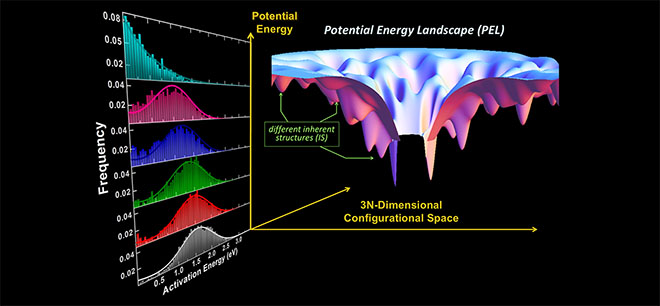
The cutting-edge research of Yue Fan, University of Michigan Assistant Professor of Mechanical Engineering, was published in the May 19th edition of Nature Communications titled “Energy Landscape-Driven Nonequilibrium Evolution of Inherent Structure in Disordered Material.”
The research focused on metallic glass, a novel material system with significantly different properties from traditional metal.
According to Fan, metallic glass differs from traditional metal because its constituent atoms are not in an ordered lattice pattern but rather a disordered atomic structure.
For example, if you were to put traditional metal under a high-resolution microscope most atoms would arrange in a very ordered lattice type pattern. However, this lattice structure is not perfect. Some atoms would deviate from the lattice sites, which are known as defects. The mechanical properties of traditional metals are controlled by those topological defects.
Because of the distinct differences in the properties of metallic glass as compared to traditional metal, metallic glass is stronger and in turn sought after.
“The random distributions of atoms are very similar to the microstructures in liquids, therefore metallic glass is also known as ‘liquid metal,’” said Fan. There is an advantage with metallic glass compared to traditional metal because if you don’t have that lattice structure, you don’t have those defects, which in turn make the traditional metal weaker. Because of this, metallic glass is very strong and has a high resistance to harsh environments. However, although metallic glass has promising properties, as engineers, we want to find some structure-property relationship. For traditional metal this is easy because the structures naturally tie with the defects and we’re able to change materials’ properties by controlling the well-defined defects. But, because in metallic glass the atoms are arranged in random patterns, it’s more difficult to solve this problem from a defect-based perspective,” he added.
Fan and his collaborators tried to use a new concept called ‘potential energy landscape (PEL)’ to tackle such a complex material system, and they were able to build a self-consistent mathematical framework to describe how the PEL structure is correlated with materials properties.
“Such quantitative description paves the way to identify optimized routes in processing space and thus to develop glassy materials with improved ductility and enhanced mechanical properties,” said Fan.
The study was collaborated with Prof. Takuya Iwashita (Oita University, Japan), and Prof. Takeshi Egami (University of Tennessee).
